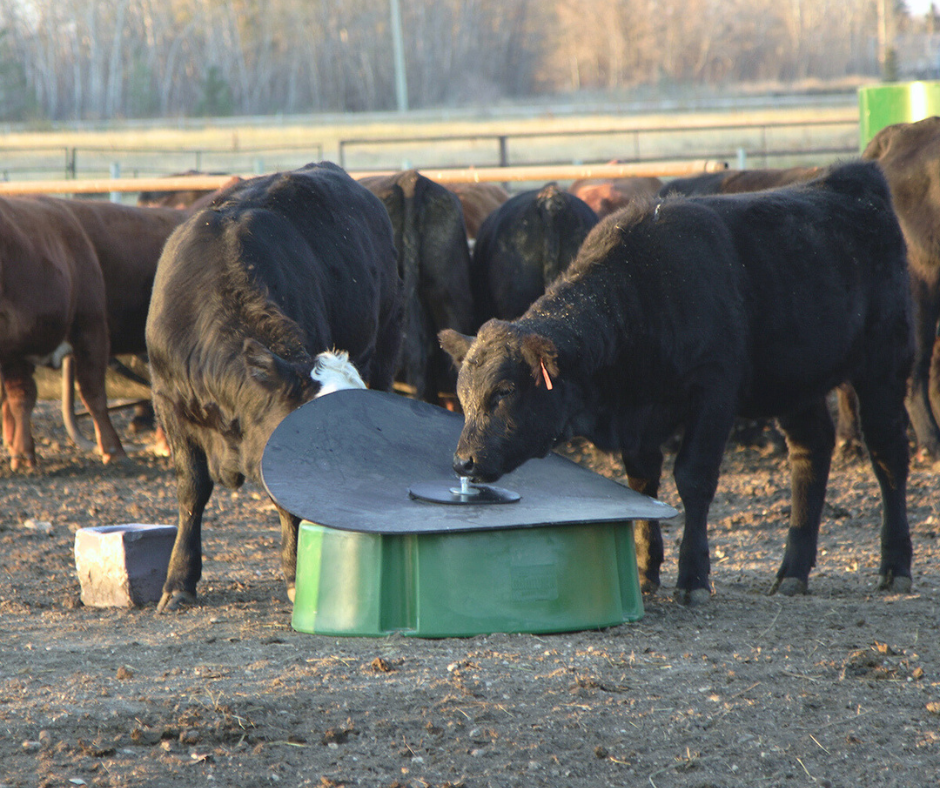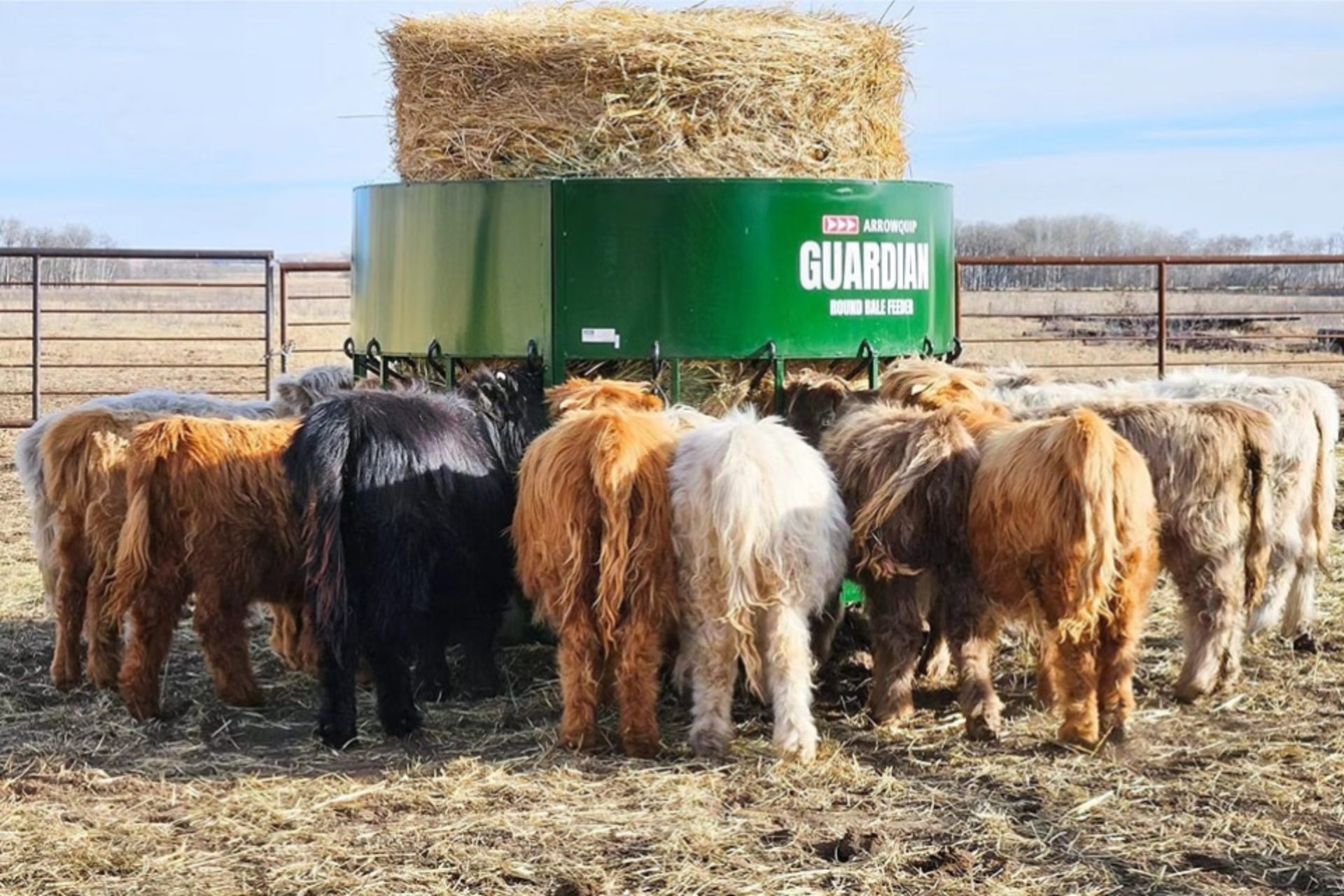The Secret to Making Feed Go Further: Unlock Savings with a Cattle Mineral Feeder and Round Bale Feeder
Understanding Why Feed Efficiency Matters on Today’s Cattle Operations
Go Back to All BlogsPosted on: March 14, 2024
Updated on: December 30, 2025
Author: Dana Charban
SHARE:
Managing a successful cattle operation requires a lot of planning and careful consideration to ensure optimal health and well-being of your herd no matter the season. Whether you’re in the middle of calving, or your herd is away at pasture, the way you feed your cattle is always changing. That’s why the equipment you use to feed your cattle, such as round bale feeders and cattle mineral feeders, is very important to consider.
Oftentimes, the durability and longevity of cattle feeders gets overlooked, which can lead to unforeseen costs for cattle producers, and significantly impact your bottom line. By understanding the value of durability and making informed decisions, you can avoid the financial burden of frequent feeder replacement and repair costs.
If you’re not sure where to start, this guide will help you choose the right cattle mineral feeder or bale feeder for your operation for a more sustainable and cost-effective future.

Understanding the Value of Durability
The cattle industry is fast paced, and things can change as quickly as overnight. Due to this, when ranchers purchase smaller cattle equipment items, like mineral feeders for cattle and round bale feeders, it is often a quick decision, and things like quality, longevity, and durability are not top deciding factors.
Cattle mineral feeders and bale feeders go through a lot – from being exposed to outdoor elements to cattle use – so it’s essential to choose a feeder that is built to withstand the wear and tear of ranch life. Durable cattle feeders require less maintenance through their lifespan which will free up valuable time and money that could be used for other, more important things on your operation.
What Makes a Durable Cattle Feeder?
Yes, a durable cattle feeder is important, but how do you know if it’s durable? Both cattle mineral feeders and round bale feeders should be constructed from materials that are going to withstand the outdoors as well as the wear and tear of daily use.
If you’re looking at purchasing a new round bale feeder, look at ones that are constructed using heavy-duty North American steel that is thick enough to withstand anything from bulls pushing on it to bale spears potentially piercing the feeder. It’s also important to consider whether the bale feeder is powder coated or galvanized. A round bale feeder that is powder coated is more likely to stand against the elements and last longer, whereas a feeder that is galvanized is more prone to rust, which means you may have to replace it sooner.
For those considering a mineral feeder for cattle, ensure it is made from heavy-duty plastic as they will be subject to daily use and abuse from cattle, which can include pushing, kicking, and chewing on the feeder. Built with thick, heavy-duty plastic, these feeders will also be more weather-resistant which means they’ll last much longer than other mineral feeders on the market, such as those built from wood.
How Can I Save Money with a Cattle Feeder?
So, you’re looking at cattle feeders. You’ve found one that is built to withstand wear and tear, which will save you a significant amount as time goes on, but did you know there are more ways a feeder can save you money? When looking at different feeder options, you can quickly narrow down your choices by searching for feeders that are labelled as “no-waste.”
It’s no secret that cattle can be huge wasters when it comes to feed – especially hay, so you’ll want to consider investing in a no-waste round bale feeder. There are many benefits of using a bale feeder over rolling your bales or placing them without a hay ring, but you can always take it one step further with a bale feeder that is considered no-waste.
When looking to make a purchase, consider a round bale feeder that is made using a cone-shaped rod and chain suspension system. This system works by suspending bales off the ground, protecting them from animal waste, ground moisture, and other contaminants that could be in the soil, which in turn helps them last longer. The cone shape of the rod and chain system also restricts cattle’s access to the bale, so they can’t pick through to only eat the best parts, which results in less waste. By keeping bales fresh for longer and restricting access to the hay bale, you won’t have to replace them as often, which can save you a significant amount of time and money.
While using uncovered mineral tubs or scattering mineral on the ground or in a trough have been used by ranchers, these methods can be more time consuming and less cost-effective. When minerals are left exposed to the elements, such as rain or snow, they can become less appealing to cattle which will lead to increased waste, reduced intake, and potential nutrient imbalances. To avoid these issues, it is recommended you use cattle mineral feeders that feature a rubber lid that is designed to protect minerals from the elements while still allowing cattle access. By eliminating mineral waste on your operation, you won’t have to fill the feeder as often which will lead to considerable financial savings.
Considerations When Buying Cattle Feeders

Though a well-built cattle mineral feeder or round bale feeder may have a higher price tag, a cattle feeder is more than just a financial decision; it’s an investment toward the long-term success and sustainability of your cattle operation. By prioritizing cattle feeders that are durable and designed to reduce waste, you can achieve significant cost savings and improve efficiency.
When choosing a feeder, not only should you consider the above factors, but you should keep in mind the brand, warranty coverage, and customer reviews. You want to work with a reputable company that stands behind their customers through industry-leading warranty and top-tier Client Care.
At the end of the day, you want what’s best for your operation, so ensure the feeder you buy, whether it’s a mineral feeder or a hay feeder, works for you and your herd.